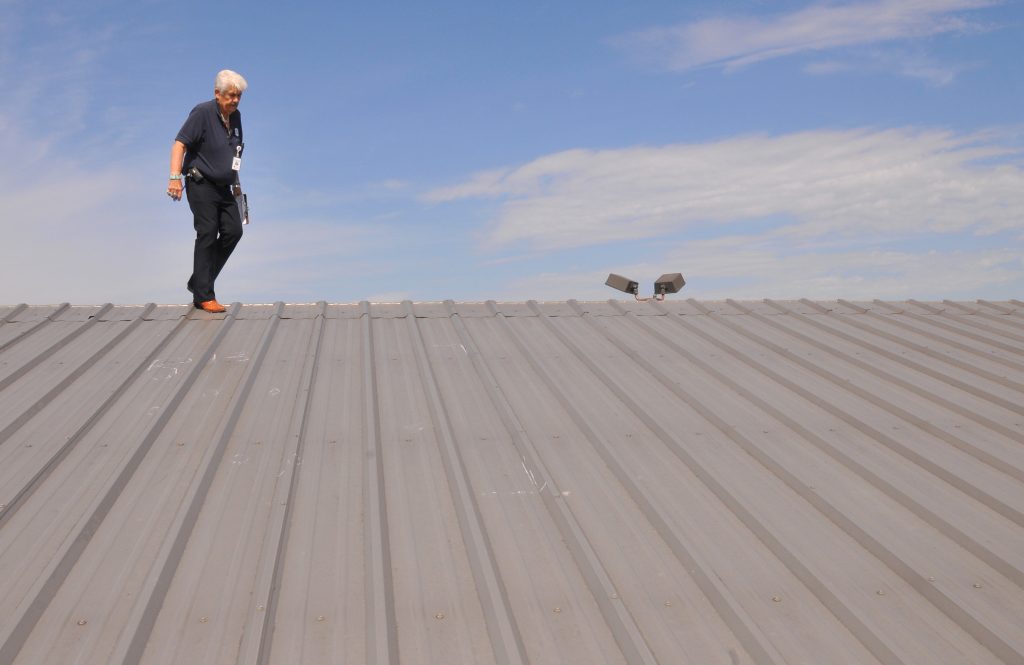To replace your roof after hail damage, you’ll typically need to spot at least seven to ten impacts in a 10×10 foot area. Most insurance adjusters require at least eight visible strikes to approve a claim. While checking for dents or granule loss can help you assess damage, a thorough inspection is crucial to guarantee accuracy. Want to know more about handling hail damage and filing claims? There’s plenty more important information ahead!

What Really Counts as Enough Hail Damage to Get a New Roof?
When it comes to hail damage, knowing the right numbers can make all the difference in getting a new roof.
You might be surprised that factors like roof age, materials, and even your location play a significant role in the assessment.
Let’s break down what really counts as enough damage to qualify for a roof replacement.
The Real Numbers: How Many Hail Strikes Trigger a Roof Replacement?
Determining how many hail strikes trigger a roof replacement can be a bit tricky, as it often depends on specific insurance policies.
Typically, you’ll need 7-10 visible hail damage impacts within a 10×10 foot area for consideration.
Insurance adjusters usually seek at least eight strikes to approve a roof replacement, emphasizing the importance of thorough inspections to guarantee accurate assessments.
Why Roof Age, Materials, and Location Matter More Than You Think
Understanding how roof age, materials, and location impact hail damage assessments can be just as important as knowing the number of hail strikes needed for a replacement.
Older roofs often face more scrutiny, while certain roofing materials, like asphalt shingles, are more vulnerable.
Furthermore, living in hail-prone areas might mean lenient insurance thresholds, making it essential to assess all these factors carefully.
How to Spot Hail Damage on Your Roof (Before It Gets Worse)
After a hailstorm, it’s essential to check your roof for visible signs of damage.
You can spot issues like dents on shingles and granules in your gutters from the ground.
However, for a thorough assessment, don’t hesitate to call in a pro to make sure nothing’s missed.
Signs You Can See From the Ground
While you mightn’t be able to climb onto your roof to check for hail damage, there are several signs you can spot from the ground that can alert you to potential issues.
Look for noticeable dents on shingles, dark spots on ceilings, or granule loss in gutters.
These signs of hail damage can guide you to inspect the roof further for any necessary repairs.
When You Need a Pro’s Eye: The Importance of a Roof Inspection
When severe hailstorms strike, it’s essential to have your roof inspected by a professional to catch any damage before it worsens.
While you might notice signs of damage like dents in gutters, a professional roof inspection provides a thorough assessment of shingles and flashing.
This guarantees you address all issues, helping you protect your home and navigate the insurance claims process effectively.
Will Your Insurance Cover a Roof Replacement for Hail Damage?
When it comes to insurance coverage for hail damage, understanding the difference between Actual Cash Value and Replacement Cost policies is essential.
You’ll want to document any damage thoroughly to support your claim and increase your chances of getting the financial help you need.
Let’s investigate how these factors can impact your roof replacement process.
The Difference Between Actual Cash Value and Replacement Cost Policies
Understanding the difference between Actual Cash Value (ACV) and Replacement Cost Value (RCV) policies is essential for homeowners facing hail damage.
ACV policies pay based on your roof’s depreciated value, which might leave you out-of-pocket for replacement costs.
In contrast, RCV policies cover the full replacement cost, ensuring you’re protected and supported through the roof replacement process.
Choose wisely to safeguard your home.
How to Document Damage the Right Way
How can you effectively document hail damage to maximize your chances of a roof replacement claim?
Start by taking high-quality photos of dents and granule loss.
Note the storm’s date and time, and describe the damage in detail.
Collaborate with a roofing contractor for a professional inspection report.
This thorough documentation will strengthen your insurance claim for hail damage.
How Long Do You Have to File an Insurance Claim for Hail Damage?
If you’ve recently experienced a hailstorm, it’s crucial to know that you typically have one year from the storm’s date to file an insurance claim for any resulting damage.
Here are some key points to remember:
- Check your policy for specific timelines.
- Document all damage immediately.
- Know the storm date.
- File promptly to avoid delays.
Understanding how long you have to file an insurance claim for hail damage can make a difference.
Filing a Roof Replacement Claim for Hail Damage: Step-by-Step Guide
When evaluating hail damage for your roof, it’s essential to recognize that different hail sizes can cause varying levels of harm.
You’ll want to watch for dents, cracks, and missing shingles, as these signs can impact your claim’s success.
Understanding the nuances of damage helps you document effectively and strengthen your case with your insurer.
Different Hail Sizes, Different Damage: What to Watch For
What should you look for when evaluating hail damage to your roof?
- Dents or dings on shingles
- Impact marks on roof vents
- Damage to gutters
- Flaws in flashing
If you notice signs like these, it may be time to contemplate roof replacement.
Document all hail damage to support your claim and guarantee you’re prepared for any insurance discussions.
Want a Roof That Can Handle the Next Storm? Consider Hail-Resistant Options
If you want a roof that stands strong against hail, it’s essential to choose the right materials.
Hail-resistant options like impact-resistant shingles or metal roofs can make a significant difference in protecting your home.
Regular inspections also play a key role in maintaining your roof’s integrity, ensuring it’s ready for the next storm.
The Best Roofing Materials for Hail Protection
As severe storms become more frequent, protecting your home with the right roofing materials is essential.
Consider these hail-resistant options to enhance your home’s safety and potentially lower hail damage insurance costs:
- Impact-rated shingles
- Durable metal roofs
- Resilient slate or tile
- Lightweight rubber materials
Investing in these hail-resistant roofing materials not only safeguards your home but also serves your community by promoting resilience.
Why Regular Inspections Are Worth It
Investing in hail-resistant roofing materials is just the first step in safeguarding your home from severe storms.
Regular inspections can catch minor hail damage early, preventing significant issues down the line. By addressing vulnerabilities proactively, you’re not only protecting your investment but also ensuring your roof lasts longer.
Schedule inspections after storms, and keep your home safe for those you care about.
Not Sure If Your Roof Needs a Replacement After Hail? Let Heins Contracting Help
Wondering whether your roof needs a replacement after a hailstorm? Heins Contracting’s team can help you assess the situation.
Here’s what they’ll check:
- Dents in shingles
- Loss of granules
- Hidden damage
- Insurance documentation
Our professional roofing expertise guarantees you make informed decisions about your hail damage roof, protecting your home and investment.
Don’t hesitate to reach out!




